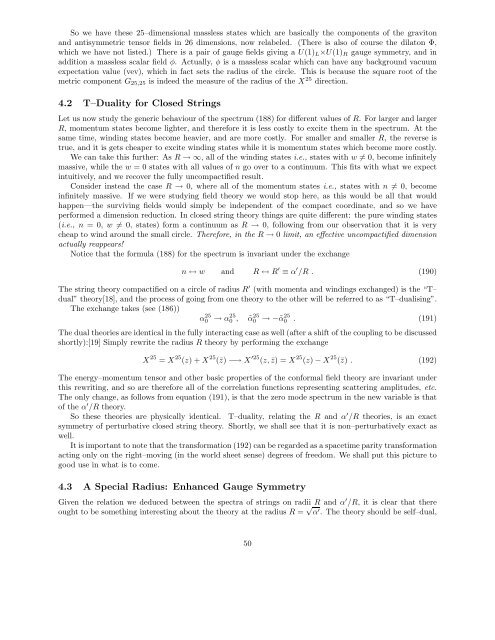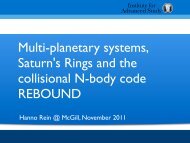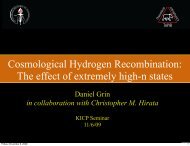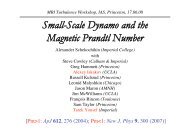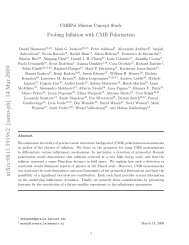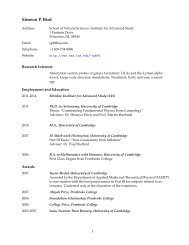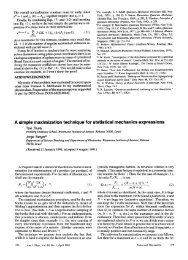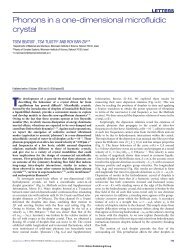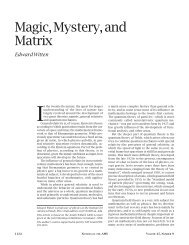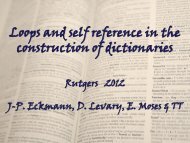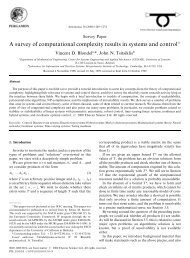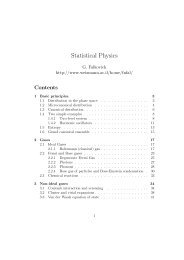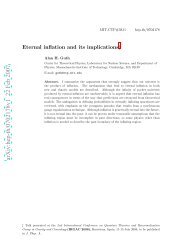Introduction to String Theory and D–Branes - School of Natural ...
Introduction to String Theory and D–Branes - School of Natural ...
Introduction to String Theory and D–Branes - School of Natural ...
Create successful ePaper yourself
Turn your PDF publications into a flip-book with our unique Google optimized e-Paper software.
So we have these 25–dimensional massless states which are basically the components <strong>of</strong> the gravi<strong>to</strong>n<br />
<strong>and</strong> antisymmetric tensor fields in 26 dimensions, now relabeled. (There is also <strong>of</strong> course the dila<strong>to</strong>n Φ,<br />
which we have not listed.) There is a pair <strong>of</strong> gauge fields giving a U(1)L×U(1)R gauge symmetry, <strong>and</strong> in<br />
addition a massless scalar field φ. Actually, φ is a massless scalar which can have any background vacuum<br />
expectation value (vev), which in fact sets the radius <strong>of</strong> the circle. This is because the square root <strong>of</strong> the<br />
metric component G25,25 is indeed the measure <strong>of</strong> the radius <strong>of</strong> the X 25 direction.<br />
4.2 T–Duality for Closed <strong>String</strong>s<br />
Let us now study the generic behaviour <strong>of</strong> the spectrum (188) for different values <strong>of</strong> R. For larger <strong>and</strong> larger<br />
R, momentum states become lighter, <strong>and</strong> therefore it is less costly <strong>to</strong> excite them in the spectrum. At the<br />
same time, winding states become heavier, <strong>and</strong> are more costly. For smaller <strong>and</strong> smaller R, the reverse is<br />
true, <strong>and</strong> it is gets cheaper <strong>to</strong> excite winding states while it is momentum states which become more costly.<br />
We can take this further: As R → ∞, all <strong>of</strong> the winding states i.e., states with w = 0, become infinitely<br />
massive, while the w = 0 states with all values <strong>of</strong> n go over <strong>to</strong> a continuum. This fits with what we expect<br />
intuitively, <strong>and</strong> we recover the fully uncompactified result.<br />
Consider instead the case R → 0, where all <strong>of</strong> the momentum states i.e., states with n = 0, become<br />
infinitely massive. If we were studying field theory we would s<strong>to</strong>p here, as this would be all that would<br />
happen—the surviving fields would simply be independent <strong>of</strong> the compact coordinate, <strong>and</strong> so we have<br />
performed a dimension reduction. In closed string theory things are quite different: the pure winding states<br />
(i.e., n = 0, w = 0, states) form a continuum as R → 0, following from our observation that it is very<br />
cheap <strong>to</strong> wind around the small circle. Therefore, in the R → 0 limit, an effective uncompactified dimension<br />
actually reappears!<br />
Notice that the formula (188) for the spectrum is invariant under the exchange<br />
n ↔ w <strong>and</strong> R ↔ R ′ ≡ α ′ /R . (190)<br />
The string theory compactified on a circle <strong>of</strong> radius R ′ (with momenta <strong>and</strong> windings exchanged) is the “T–<br />
dual” theory[18], <strong>and</strong> the process <strong>of</strong> going from one theory <strong>to</strong> the other will be referred <strong>to</strong> as “T–dualising”.<br />
The exchange takes (see (186))<br />
α 25<br />
0 → α 25<br />
0 , ˜α 25<br />
0 → −˜α 25<br />
0 . (191)<br />
The dual theories are identical in the fully interacting case as well (after a shift <strong>of</strong> the coupling <strong>to</strong> be discussed<br />
shortly):[19] Simply rewrite the radius R theory by performing the exchange<br />
X 25 = X 25 (z) + X 25 (¯z) −→ X ′25 (z, ¯z) = X 25 (z) − X 25 (¯z) . (192)<br />
The energy–momentum tensor <strong>and</strong> other basic properties <strong>of</strong> the conformal field theory are invariant under<br />
this rewriting, <strong>and</strong> so are therefore all <strong>of</strong> the correlation functions representing scattering amplitudes, etc.<br />
The only change, as follows from equation (191), is that the zero mode spectrum in the new variable is that<br />
<strong>of</strong> the α ′ /R theory.<br />
So these theories are physically identical. T–duality, relating the R <strong>and</strong> α ′ /R theories, is an exact<br />
symmetry <strong>of</strong> perturbative closed string theory. Shortly, we shall see that it is non–perturbatively exact as<br />
well.<br />
It is important <strong>to</strong> note that the transformation (192) can be regarded as a spacetime parity transformation<br />
acting only on the right–moving (in the world sheet sense) degrees <strong>of</strong> freedom. We shall put this picture <strong>to</strong><br />
good use in what is <strong>to</strong> come.<br />
4.3 A Special Radius: Enhanced Gauge Symmetry<br />
Given the relation we deduced between the spectra <strong>of</strong> strings on radii R <strong>and</strong> α ′ /R, it is clear that there<br />
ought <strong>to</strong> be something interesting about the theory at the radius R = √ α ′ . The theory should be self–dual,<br />
50


